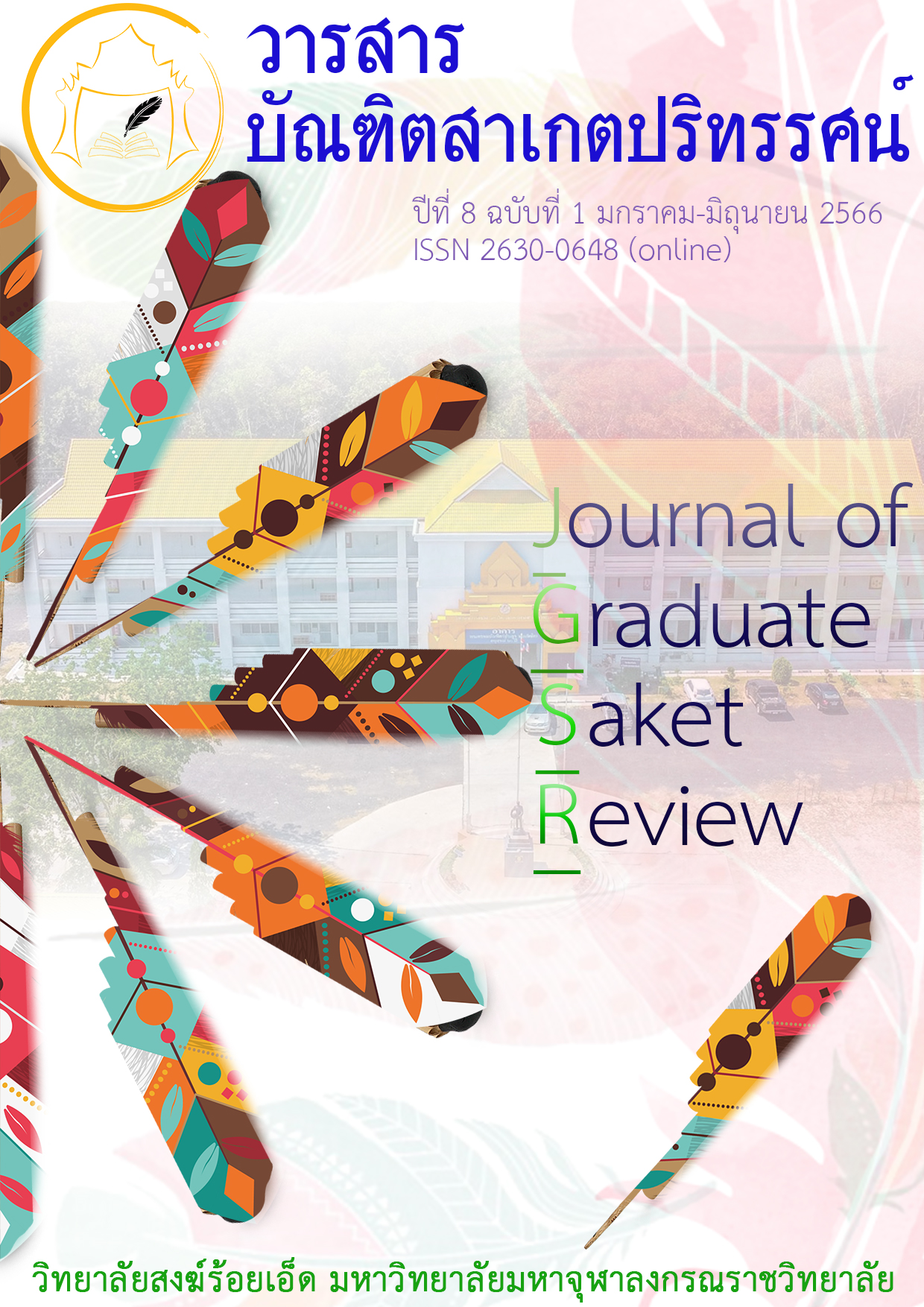The condition student-centered teaching and learning management according to the seven Kalyāṅamitta dhammas of secondary school teachers in the lak mueang loei united campus group under the nong bua lam phu secondary education service area
Main Article Content
Abstract
The objectives of this research were: 1) to study the condition of student-centered teaching and learning management of secondary school teachers in the lak mueang loei united campus group under the nong bua lam phu secondary education service area office; 2) to study the guidelines for student-centered teaching and learning management according to the Seven Kalyāṅamitta dhammas of secondary school teachers in the lak mueang loei united campus group. The sample group used in the research consisted of 260 participants and five experts. The research tools were a questionnaire with a reliability value of 0.935 and an interview form. The statistics used to analyze the data were: frequency, percentage, mean, standard deviation, and content analysis.
The research results were as follows:
1. The condition of student-centered teaching and learning management in five aspects was rated at a high level, followed by the use of information technology media and, learning resources that are conducive to learning.
2. The guidelines for student-centered teaching and learning management according to the seven Kalyāṅamitta dhammas of secondary school teachers in the lak mueang loei united campus group were: (1) teachers should design the learning process for learners to learn happily, motivate students to be enthusiastic about learning. Moreover, teachers give constant reinforcement and encouragement to learners. (2) Teachers should be friendly, understand students, behave appropriately and give good guidelines to conduct their life correctly. (3) Teachers should know how to explain, give advice, and warn students about what they should and should not do. (4) Teachers should explain the complicated contents to make the students understand clearly. (5) Teachers should be ready to listen to advice, ask questions, make suggestions and criticize. They should be good listeners if the students consult them about their problems. They endure all obstacles, have a strong mind, and can overcome various obstacles with a stable mind.
Article Details

This work is licensed under a Creative Commons Attribution-NonCommercial-NoDerivatives 4.0 International License.
เนื้อหาและข้อมูลในบทความที่ลงตีพิมพ์ในวารสารบัณฑิตสาเกตปริทรรศน์ ถือเป็นข้อคิดเห็นและความรับผิดชอบของผู้เขียนบทความโดยตรงซึ่งกองบรรณาธิการวารสาร ไม่จำเป็นต้องเห็นด้วย หรือร่วมรับผิดชอบใด ๆบทความ ข้อมูล เนื้อหา รูปภาพ ฯลฯ ที่ได้รับการตีพิมพ์ในวารสารบัณฑิตสาเกตปริทรรศน์ ถือเป็นลิขสิทธิ์ของวารสารบัณฑิตสาเกตปริทรรศน์ หากบุคคลหรือหน่วยงานใดต้องการนำทั้งหมดหรือส่วนหนึ่งส่วนใดไปเผยแพร่ต่อหรือเพื่อกระทำการใด ๆ จะต้องได้รับอนุญาตเป็นลายลักอักษรจากวารสารบัณฑิตสาเกตปริทรรศน์ ก่อนเท่านั้น
References
ภาษาไทย
กฤษฎา ศรีจันฮด. (2557). ศึกษาครูและหลักกัลยมิตรธรรม ๗ ในพระไตรปิฎก. สารนิพนธ์พุทธศาสตรดุษฏีบัณฑิต. บัณฑิตวิทยาลัย มหาวิทยาลัยมหาจุฬาลงกรณราชวิทยาลัย.
กลุ่มนโยบายและแผน สำนักงานเขตพื้นที่การศึกษามัธยมศึกษา เขต 19. (2563). แผนพัฒนาการศึกษาขั้นพื้นฐาน (3 ปี). ปีงบประมาณ พ.ศ. 2563 - 2564. กลุ่มนโยบายและแผน สำนักงานเขตพื้นที่การศึกษามัธยมศึกษา เขต 19.
ประทีป พืชทองหลาง. (2561). รูปแบบการปรึกษาเชิงพุทธตามหลักกัลยาณมิตร. วารสารปรัชญาและศาสนา. 3(2), 75-99.
วารินท์พร ฟันเฟื่องฟู. (2562). การจัดการเรียนรู้ Active Learning ให้สำเร็จ. วารสารวไลยอลงกรณ์ปริทัศน์. 9(1), 135-145.
สุดเฉลิม ศัสตราพฤกษ์. (2562). การจัดการเรียนการสอนในศตวรรษที่ 21 แบบห้องเรียนกลับด้านเพื่อการพัฒนาทักษะการเรียนรู้และ นวัตกรรม. วารสารวไลยอลงกรณ์ปริทัศน์. 1(28), 100-108.
Puspitarini and Hanif. (2562). วารสารวไลยอลงกรณ์ปริทัศน์. การใช้สื่อการเรียนรู้เพื่อเพิ่มแรงจูงใจในการ เรียนรู้ในโรงเรียนประถมศึกษา. มนุษยศาสตร์และสังคมศาสตร์. 2(4), 53-60.
ภาษาอังกฤษ
Kitsada Sreechanhod. (2014). A Study of Sevenfold Kalyāṅamitta -Dhamma in tipitaka for teachers.
Prateep Phuetthonglang. (2018). Buddhist Counseling Model According to Kalyāṅamitta , Journal of Philosophy and Religion. 3(2), 75-99.
Policy and Plan Group Office of Secondary Education Service Area 19. (2020). Basic Education Development Plan (3 years) Fiscal Year 2020 - 2021. Policy and Plan Group Office of Secondary Education Service Area 19.
Puspitarini and Hanif. (2019). Using learning materials to increase learning motivation in primary schools. Journal of Humanities and Social Sciences. 2 (4), 53-60.
Soodchalerm Sattrapruek. (2019). Teaching and learning management in the 21st century with a reverse classroom model for the development of learning skills and innovation. Valaya Alongkorn Review Journal. 1(28), 100-108.
Warinporn Funfuangfu. (2019). Learning Management Active Learning to be successful. Valaya Alongkorn Review Journal. 9(1), 135-145.


